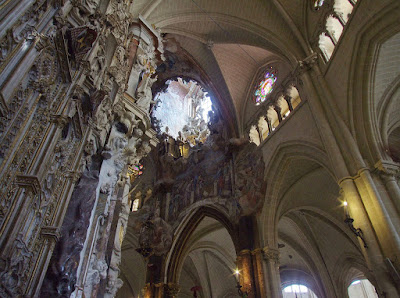 |
| El Transparente of Toledo Cathedral |
Reviewed by Robert Hugill on May 17 2017
Star rating:
Rich textures from the Spanish golden age in the Tallis Scholars final Cadogan Hall concert of the season
Peter Phillips and the Tallis Scholars were in Iberian mood for their concert at Cadogan Hall on Wednesday 17 May 2017, the final concert in the 2016/17 Choral at Cadogan Series. A Spanish Renaissance included a performance of the Missa Mille regretz by Christobal de Morales, alongside motets by Morales and Tomas Luis de Victoria, plus Alonso Lobo's Lamentations and finishing with Victoria's Magnificat primi toni.
Phillips explained that the group was giving a concert in Toledo Cathedral, and we were getting a preview of the programme which included music by two composers associated with the cathedral, Morales (who was chapelmaster from 1545 to 1547) and Lobo (who was chapelmaster from 1593-1604).
Morales' Missa Mille regretz is based on a chanson, Mille regretz, attributed to Josquin; the chanson also went under the name of La cancion del Emperador (The Emperor's Song), the emperor in question being Charles V, Holy Roman Emperor and King of Spain. Morales' mass takes material from the chanson and creates a six-part mass, with the chanson appearing generally in the soprano . But before the mass, four singers from the ensemble performed Josquin's stunningly beautiful and rather melancholy song.
The 'Kyrie' revealed the gently unfolding yet rich texture of the music, with a surprising strength in the middle and lower parts (the mass features two soprano and two alto parts plus one tenor and one bass), with lightly floating soprano parts above. The mass generally kept this same lovely richness of texture throughout, with only occasional moments of contrast. The 'Gloria' was quite vigorous and fast moving, with just a gentler moment in the 'qui tollis'. In the 'Credo' the fast moving music had a very imitative texture, with a slower, luscious moment at the 'et incarnatus'. The concluding section included a lovely change in texture with a section for three soloists (soprano, alto and tenor), before the full choir return for the rich and strong closing pages. The 'Sanctus' seemed to feature gently rolling waves of music, with a highly rhythmic 'Hosanna' and a lovely 'Benedictus' for three rather contrapuntal soloists (soprano, alto and bass). The final 'Agnus Dei' showed off Morales' skill to perfection, as essentially it was the same as the previous movements, yet different. Throughout the work Morales showed deft skill in the remarkable amount of variety he could achieve in the richly texture six-part structure, and the concluding 'Agnus Dei' was very moving.
After the interval we heard a sequence of motets by Victoria and Morales. Victoria's Dum complerentur was a surprisingly substantial piece which received a vivid and up-front performance, with joyous Alleluias punctuating the music. Victoria's five-part Regina Coeli was poised yet lively, this was very much civilised joy with some long contrapuntal lines, whilst Morales' six-part Regina Coeli was vibrant with a gorgeous texture arising from six moving parts.
Alonso Lobo wrote at least two sets of Lamentation, though one survives in only fragmentary form and we heard an abridged account of those held in Seville Cathedral. The music was sung with grave dignity, the music given a performance of concentrated and sustained intensity to create a remarkable whole. Morales' Emendemus in melius was similarly sombre and sober in mood.
The final work was Victoria's Magnificat primi toni, this used two unequal choirs with the majority of the piece being a dialogue between the choirs, the unevenness (on SSAT the other SATBB) creating a striking sense of contrast.Victoria brought a great deal of contrast and character in the word setting in the different sections to create a strikingly varied whole.
For an encore we were treated to a motet by a name new to me (and to many others in the audience), the Nunc Dimittis by Andres de Torrentes who was another chapelmaster at Toledo Cathedral.
Elsewhere on this blog:
- Late night club? Jasmin Toccata's Late o'Clock Baroque at London Festival of Baroque Music - concert review
- Thought-provoking: Benjamin Appl and James Baillieu's Heimat - CD review
- Virtuosic Bach & stormy Telemann: Florilegium at the London Festival of Baroque Music - concert review
- Start of a new series: Complete cello music of Stephen Dodgson - CD review
- Not quite vintage: Verdi's Don Carlo at Covent Garden - opera review
- Music and movement: Gildas Quartet at Conway Hall - concert review
- Michael Finnissy premiere: Evensong at St John's College, Cambridge
- Russian Romance: Music for voice, cello and piano from Joan Rodgers, Michael Mofidian, Guy Johnston and Sholto Kynoch - concert review
- Roller-coaster ride: My interview with pianist Stewart Goodyear - interview
- Honesty and poise: Lise Davidsen at Rosenblatt Recitals - Concert review
- Home



%20and%20kids.jpg)
.webp)





.jpg)
No comments:
Post a Comment